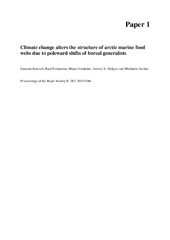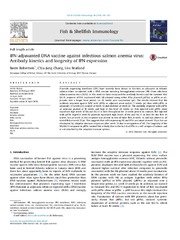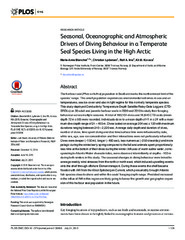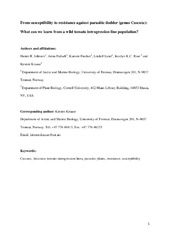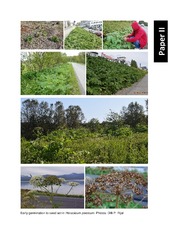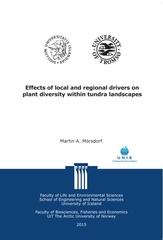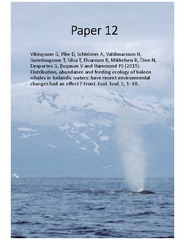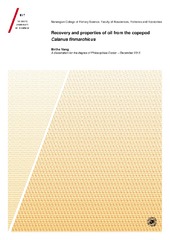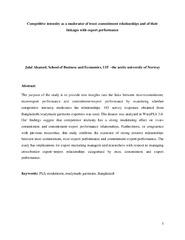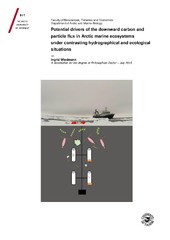Doktorgradsavhandlinger (BFE-fak): Recent submissions
Now showing items 141-160 of 277
-
Calanus® Oil. Utilization, composition and digestion
(Doctoral thesis; Doktorgradsavhandling, 2016-07-03)In the pelagic system, phytoplankton are the main producers of n-3 LC-PUFA and make up the foundation of the oceanic food web. Zooplankton, such as copepods and krill, are the most numerous primary consumers in the marine environment and have a central role in the energy transfer to higher trophic levels. The copepod Calanus finmarchicus is present in large amounts in the North Atlantic and has ... -
Speciation reversal in sympatric eco-morphs of European whitefish (Coregonus lavaretus. L) – phenotypic and genomic consequences
(Doctoral thesis; Doktorgradsavhandling, 2016-09-20)Anthropogenic activities, such as introduction of non-native species, is considered as one of the most significant causes for declining biodiversity, since such introduction may destabilise ecological barriers to gene flow between native populations. In the 1960s a salmonid fish, vendace, was introduced to the upper parts of Pasvik watercourse and during the early 1990s it invaded the entire ... -
Marine food-web structure and community patterns in high-latitude marine ecosystems
(Doctoral thesis; Doktorgradsavhandling, 2016-06-24)This PhD deals with spatial and temporal community patterns in Barents Sea marine food webs and benthic communities in Svalbard. A main aim of this PhD project has been to study how community and food-web structure changes along environmental and climatic gradients, and to elucidate how species respond to climate warming in the Arctic. We used network analysis to study how the network of who eats ... -
Stakeholder Involvement in the Governance of Fisheries in Europe: With perspectives of the result-based management
(Doctoral thesis; Doktorgradsavhandling, 2016-05-27)The PhD project study is about ‘stakeholder participation’ in fisheries governance; a concept that has become acceptable in all areas of decision-making during the last few decades, partly due to dissatisfaction with the performance of fisheries management systems across the world. Among other issues, discarding, especially of marketable fish, is a serious and continuing problem despite the heavy ... -
Atlantic salmon type I interferons: Protection against virus infection in vivo and function as adjuvants in a virus DNA vaccine.
(Doctoral thesis; Doktorgradsavhandling, 2016-08-25)Fish farming has been considered the importance resource for supplying food for the global requirement. Norway by far is the country that produces the most salmon in the world, and virus disease is one of the major problems that causes the economic loss in fish farming. For combating the diseases, the vaccine has been developed. In Norway, traditional vaccines based on inactivated virus are ... -
Valuing Unfamiliar and Complex Ecosystem Services: The influence of survey mode, knowledge and dishonesty
(Doctoral thesis; Doktorgradsavhandling, 2016-08-15)Increasing demand for valuation of ecosystem services has led stated preference methods to be applied to public goods that are increasingly complex and unfamiliar. Traditionally, stated preference surveys were conducted via mail or face-to-face interviews, but over the past two decades internet panels have been used to a larger extent. As we move away from traditional methods of survey administration ... -
Genetic complexity in the marine environment: Population genomics of saithe (Pollachius virens), Greenland halibut (Reinhardtius hippoglossoides), beaked and golden redfish (Sebastes mentella and S. norvegicus) in the North Atlantic
(Doctoral thesis; Doktorgradsavhandling, 2016-05-04)In this work, I investigated genetic complexity in four commercially exploited species from the North Atlantic: saithe (Pollachius virens L.), Greenland halibut (Reinhardtius hippoglossoides), and beaked and golden redfish (Sebastes mentella and S. norvegicus). The results were used 1) to assess the consistency between current management units and units identified by results based on genetic data ... -
Breathtaking brains Intrinsic neural adaptations to hypoxia
(Doctoral thesis; Doktorgradsavhandling, 2016-04-07)To maintain and restore the membrane potential that is crucial for normal function of neurons, the brain requires a constant and high energy supply. This supply is mainly covered by oxidative metabolism. When oxygen supply is impaired on a cellular level (hypoxia), such as in the case of stroke, neural energy levels become inadequate to maintain ion balance, leading to excessive ion flux and ultimately ... -
The Economics of Open-Access Fisheries: Subsidies and Performance of Vietnamese Fisheries
(Doctoral thesis; Doktorgradsavhandling, 2016-03-10)This dissertation focuses on analysing the economics of an open-access fishery and on evaluating the effects of government subsidy programmes on the fishing industry. The dissertation adopts a sustainable development perspective for assessing the effects of subsidies. Although the key focus of the research is on the economic effects of subsidies, the ecological and social dimensions are taken into ... -
At-sea behaviour of the world's northernmost harbour seal (Phoca vitulina) population in a changing Arctic
(Doctoral thesis; Doktorgradsavhandling, 2016-04-15)The earth is experiencing warming at a rate that challenges the adaptive capacities of many animal species. Because marine mammals can integrate and reflect ecological variation across various spatial and temporal scales, they are prime sentinels of marine ecosystem change. This thesis explores movement patterns and foraging behaviour, and the ontogeny of these behaviours, in harbour seals (Phoca ... -
Taxonomic and functional approaches of trophic interactions between large herbivores and plant communities in a mountain ecosystem
(Doctoral thesis; Doktorgradsavhandling, 2015-12-08)Given the key role of large herbivores on species and functional plant diversity, we aimed at better understanding the relationship between herbivory and plant communities mainly at a fine-scale, in order to reconcile objectives of population management and plant conservation. For this purpose, we used both taxonomic and functional approaches, and studied interactions at the inter- and intra-specific ... -
Seaweed proteins - how to get to them? Effects of processing on nutritional value, bioaccessibility and extractability
(Doctoral thesis; Doktorgradsavhandling, 2016-03-11)As a consequence of the expected population growth towards 2050, the demand for food, and in particular proteins, will increase. Due to limited resources of arable land and freshwater, this increase cannot come in the agricultural sector alone. At present, the utilization of marine environments for food production is low and should be increased. Seaweeds are fast-growing plants occurring in marine ... -
Analysis of processes at the haustorial interfaces between Cuscuta reflexa and its hosts
(Doctoral thesis; Doktorgradsavhandling, 2014-08-27)The genus Cuscuta comprises a group of holoparasitic dicotyledonous angiosperms that cause damage to many economically important crops. Parasitic plants form physical and physiological connections (haustoria) with the parenchyma and vascular vessels of compatible host plants. These connections provide them with water, mineral nutrients and organic compounds. Over time, this life style has led to ... -
Invasive Heracleum in northern Europe: Introduction history and impact on native plant diversity
(Doctoral thesis; Doktorgradsavhandling, 2016-01-15)Exotic invasive giant hogweeds are infamous in Europe for their ecological and economic damage; however, the magnitude of their impact on plant diversity has not yet been fully explored. In addition, uncertainties in their source and route of introduction impede management interventions. In such cases, molecular markers may bridge gaps between invasion history and management by providing insight ... -
Effects of local and regional drivers on plant diversity within tundra landscapes
(Doctoral thesis; Doktorgradsavhandling, 2015-12-21)In tundra, the diversity within vascular plant communities (alpha diversity) is known to be determined by local drivers such as habitat productivity and ungulate grazing. However, little is known how such local drivers modify the diversity between communities (beta diversity). Furthermore, diversity patterns may be constrained by the size of the regional species pool, which in turn may mediate the ... -
Decadal changes in distribution, abundance and feeding ecology of baleen whales in Icelandic and adjacent waters. A consequence of climate change?
(Doctoral thesis; Doktorgradsavhandling, 2016-01-15)Five species of baleen whales are regularly encountered at their feeding grounds in Icelandic waters during summer. Systematic monitoring of distribution and abundance of cetaceans in Icelandic and adjacent waters was initiated in 1987 as a part of the North Atlantic Sightings Surveys (NASS). In this thesis, the objecive is to summarize the results of these surveys in relation to changes in the ... -
Recovery and properties of oil from the copepod Calanus finmarchicus
(Doctoral thesis; Doktorgradsavhandling, 2016-01-29)The limited amount of fish oils available has led to extensive search for alternative sources of oils rich in health beneficial long-chain polyunsaturated ω-3 fatty acids. The zooplankton Calanus finmarchicus, also known as redfeed, is present in large amounts in the North Atlantic and has lipid-rich stages, which can be harvested. One of the main objectives of this study was to investigate if the ... -
Spatial and temporal variations in parasite communities of freshwater fish in the subarctic
(Doctoral thesis; Doktorgradsavhandling, 2015-11-03)Parasite communities are complicated systems believed to be affected by multiple ecological and environmental factors, both in time and space. These communities might be disrupted by anthropogenic host introductions which unfortunately appear to be a common practice e.g. in freshwater fish management. By addressing parasite occurrences in three of the most common freshwater fish species in subarctic ... -
Antecedents and outcomes of exporter – importer relationship quality - An exporting developing country’s context
(Doctoral thesis; Doktorgradsavhandling, 2015-11-13) -
Potential drivers of the downward carbon and particle flux in Arctic marine ecosystems under contrasting hydrographical and ecological situations
(Doctoral thesis; Doktorgradsavhandling, 2015-11-13)Detailed predictions of the downward particulate organic carbon (POC) flux in a future Arctic are challenging due to the poor understanding of potential drivers. Short-term sediment traps, partly modified with gel-containing jars, were deployed in the Barents Sea (BS) and in Adventfjorden, Svalbard, to determine the downward POC flux and the particle flux (≥ 0.05 mm equivalent spherical diameter ...


 English
English norsk
norsk

